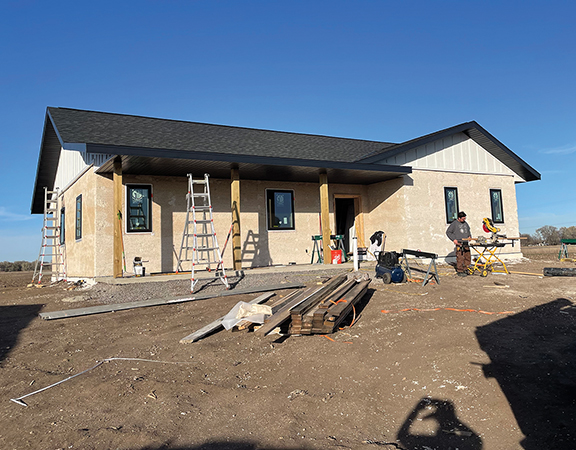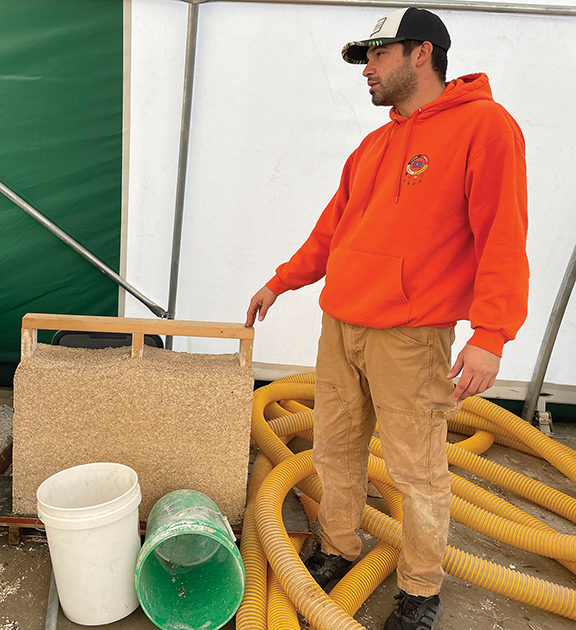
By Marcie Rendon
The Lower Sioux Community in southwest Minnesota is combining a vision for sustainable housing with the environmentally sound use of hemp. While other tribes are growing recreational or medicinal plant products, the Lower Sioux Hemp and Housing Program is leading the way for Native communities to utilize hemp for sustainable, energy-efficient housing and is the first project in Minnesota to provide ‘seed-to-wall hempcrete’.
Danny Desjarlais, the Industrial Hemp Construction Project Manager said, “The Housing Program has built the first hempcrete side-by-side emergency housing shelter in Minnesota for tribal members, as well as the first four-bedroom home. We are currently putting up a 1-bedroom tiny home using prefabricated hempcrete panels. By spring of 2024 we plan to build a 3-bedroom elder unit built to conventional housing specs to do a comparative study with the non-hemp homes the tribe has built for elders.” These studies will look at things like internal temperature regulation, air quality and moisture resistance – all environmental benefits promoted within the hempcrete industry.
Desjarlais was born and raised at Lower Sioux. As a child he was introduced to construction work by his father who owned a bridge construction company. After graduating high school, Desjarlais attended the carpentry degree program at the Minnesota West Community and Technical College where he first learned about hempcrete from tribal council member Earl Pendleton. Pendleton introduced him to the possibilities of hemp as a sustainable building option for the tribe by sending him to the US Hemp Building Summit in 2021. “Pendleton has been pushing for hemp in our community for the past 12 years or so. The Summit opened my eyes to a whole new world. I would say that was the beginning to the rest of my life. He put me in charge of all the hemp building projects for the Lower Sioux.”
Desjarlais has spent the past decade learning everything he can about hemp-how to grow it, how to harvest and process it, how to turn raw hemp into the building material called hempcrete, and how to energize workers to stick with the labor-intensive process of turning the hemp hurd into the building material hempcrete. He and his construction team, all Lower Sioux members, have learned from the best. Alex Sparrow from the UK was one of their first consultants. Desjarlais says, “He wrote the book on hempcrete.”
Pendleton then hired Jennifer Martin from Hempstone in Massachusetts to visit the rez in September of 2022. “She taught a hempcrete workshop where we started to build the concession stand for the youth to sell stuff at last season’s powwow.”
The next expert invited in was Cameron McIntosh from Americhanvre Cast Hemp from Allentown Pennsylvania. “He taught us how to spray hempcrete and helped us build the duplex, the first hemp house in Minnesota.”

The crew then traveled to Denton, Nebraska for hemp block training with Dion Lefebre from Davita Blocks, Alberta, Canada. “We retrofitted a 100-year-old general store with hemp blocks. We also had a lime plaster training on the rez this past October, again with Jennifer Martin and Tim White from Texas healthy Homes.”
Currently, with only 500 tillable acres, the tribe can plant anywhere between 100-200 acres per year. To complete the projects they are currently building they sent Lower Sioux harvested hemp out to a processing plant, contracted for more hurd from other growers and then they went to work processing the hurd.
Hurd is the wooded core of the hemp plant’s stem that is used to create the end product. The crew mixes hemp, lime and water in a ratio of 4:1:1, hemp, lime, water respectively. Then, either by hand or with a blower, they pack the hempcrete material into the walls of the house. Once the walls are dry, they apply a layer of plaster.
The hemp home walls are at least 12-inches thick and provide enough insulation for the homes to typically self-regulate to 64 degree temperatures, leading to large savings on both heating and cooling. Desjarlais anticipates the comparative studies to show that their homes are 70% more energy efficient than conventionally built homes.
Hempcrete claims the potential to produce not only a carbon neutral future, but could be part of the remedy to actually capture the overly high levels of carbon from our atmosphere. According to Anthropocene magazine, “Hemp’s rapid growth, dense canopy, and ability to grow in nutrient-poor soils make the plant more efficient than trees at sequestering carbon. In construction, hemp is combined with a lime-based binder to create hempcrete, a carbon-negative biocomposite that can sequester over 100 kilograms of CO2 per square meter.”
Additionally, hempcrete is fire-resistant, mold resistant, and pest resistant. The air quality inside a hemp home is of better quality than homes made with materials that contain fiberglass or other toxins typically present in conventional building materials. Hempcrete is 100% recyclable because it is made of all natural products. A hempcrete home has a projected lifetime of hundreds of years, compared to the typical home’s 50-to-100 year lifespan. Desjarlais referenced one hemp home built in 1698 that still stands in Japan today, with only paint touch-ups.
The Industrial Hemp Construction Project has experimented and successfully built homes using the cast-in-place method on the concession stand; the spray-applied method on the duplex, and they are currently undergoing the building of a tiny home using prefabricated hempcrete panels. By the end of 2024 the goal is to have a fully operating processing plant on the reservation to move tribally grown hemp though every stage, from the field to move-in-ready homes.
Desjarlais was invited to talk to the Leech Lake communities in early December about the Lower Sioux projects and how other communities can begin building with hemp. In August of 2023, he traveled to British Columbia to lead a hempcrete training with the Gitxsan people.
As a visionary leader in the use of hemp to create sustainable, energy-efficient homes for tribal communities, Desjarlais and his work crew, with their accumulated knowledge learned from trainings, in-house processing of hurd, and the hands-on-building of homes, they are becoming the ‘turn-to’ folks for others interested in this environmentally friendly, sustainable housing movement.
For more information, see website: https://lowersioux.com/departments/agriculture.






